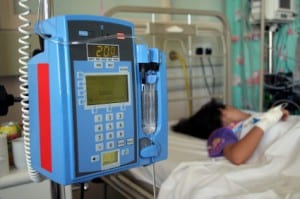Complications and nursing management of hepatic arterial infusion pumps

The hepatic arterial infusion (HAI) pump is a treatment-delivery method based on the principle of targeting the tumor site directly and can be used alone or in combination with systemic chemotherapy” Italiano (2018). Abstract: BACKGROUND: The hepatic arterial infusion (HAI) pump is a treatment-delivery method based on the principle of targeting the tumor site directly […]
Efficiency of electrocardiogram monitor for positioning PICC tip placement in neonates

During the PICC placement in neonates, the use of ECG monitor to determine the position of catheter tip can improve the one-time success rate of placement and reduce the time spent on placement” Ling et al (2018). Abstract: OBJECTIVE: To study the efficiency of electrocardiogram (ECG) monitor for positioning the catheter tip in the placement […]
Standardization of the infusion sequence of antineoplastic drugs

In this way, this study aimed to evaluate the infusion order of antineoplastic agents of the main therapeutic protocols used in the treatment of colorectal and breast cancer which are used in a tertiary hospital, identifying possible interactions dependent on the infusion sequence” Silva et al (2018). Abstract: The definition of antineoplastic administration sequences can […]
Implementation of a closed system transfer device in oncology units

The objective of this study was to evaluate the effect of CSTD implementation on central line-associated bloodstream infection (CLABSI) rates” Fox et al (2018). Background: In February 2016 the United States Pharmacopeia introduced general chapter 800 requiring the use of closed system transfer devices (CSTD) for preparation and administration of antineoplastic hazardous drugs. The objective […]
Adverse events among OPAT patients receiving daptomycin versus vancomycin

In the OPAT setting, vancomycin use was associated with higher incidence of ADEs than daptomycin use. This finding is an important policy consideration for programs aiming to optimize outcomes and minimize cost. Careful selection of gram-positive agents for prolonged treatment is necessary to limit toxicity” Schrank et al (2018). Abstract: OBJECTIVE: Outpatient parenteral antimicrobial therapy […]
Systematic review for the medical and surgical management of necrotizing soft tissue infections

To assess the effects of medical and surgical treatments for necrotizing soft tissue infections (NSTIs) in adults in hospital settings” Hua et al (2018). Abstract: BACKGROUND: Necrotizing soft tissue infections (NSTIs) are severe and rapidly spreading soft tissue infections of the subcutaneous tissue, fascia, or muscle, which are mostly caused by bacteria. Associated rates of […]
Savings associated with bedside peripherally inserted central catheter tip confirmation

In this retrospective case control study, we examine costs related to these 2 tip confirmation methods while assessing overall cost savings to the health care industry” Patel et al (2018). Abstract: Peripherally inserted central catheter use has increased dramatically over the past decade, parallel to health care costs. Traditional bedside peripherally inserted central catheter placement […]
When IV route not available consider a rectal catheter for rapid medication and fluid administration

Patients in both the post-acute and acute care settings often require fluid and/or medication when their oral route is compromised and vascular access may not be warranted or immediately accessible. The rectum is an underutilized administration point that can be accessed with speed and relative ease” Macygin et al (2018). Abstract: Health care providers are […]
Study identifies early CLABSI in patients with haematological malignancies

We observed a high prevalence of early central venous catheter associated blood stream infection mainly in patients with haematological malignancies. Our study highlights the importance of preventive measures in reducing infections in paediatric cancer patients” Moell et al (2018). Abstract: AIM: This study examined the clinical characteristics of central line associated blood stream infections occurring […]
CLABSI underreporting and data accuracy remains a major concern

CLABSI underreporting remains a major concern; validations conducted by SHDs provide an important impetus for improved reporting. SHDs are uniquely positioned to engage facilities in collaborative validation reviews that allow transparency, education, and relationship building” Bagchi et al (2018). Abstract: Background: Numerous state health departments (SHDs) have validated central line–associated bloodstream infection (CLABSI) data, and […]
Article describes automatic venipuncture device and control system

This device adopts ultrasonic image guided by the microcontroller, to achieve automatic venous catheterization” Huo et al (2017). Abstract: According to clinical PICC (Peripherally Inserted Central Catheter) catheter surgery, this project introduces a new scheme for vein puncturing device and its controlling system. This device adopts ultrasonic image guided by the microcontroller, to achieve automatic […]
Sedation decision aid in ambulatory venous access device placement

This study was undertaken to determine the influence of using a sedation decision aid when selecting a sedation option for totally implantable vascular access device placement on patient choice, workup, and recovery time” Chittle et al (2018). Abstract: This study was undertaken to determine the influence of using a sedation decision aid when selecting a […]
Factors that affect the reporting of sharps injuries at a large academic teaching hospital

The purpose of this study was to examine the incidence, attitudes, and factors that affect the reporting of sharps injuries among orthopedic surgery residents at a large academic teaching hospital in an effort to increase reporting rates and design effective interventions” Manoli et al (2018). Abstract: Sharps-related injuries represent a significant occupational hazard to orthopedic […]
Hepatitis B and C seroprevalence among medicine students in Northeast Ethiopia

The aim of this study was to determine the seroprevalence of hepatitis B and C virus infections among medicine and health science students in Northeast Ethiopia and to assess their knowledge and practice towards the occupational risk of viral hepatitis” Demsiss et al (2018). Abstract: BACKGROUND: Health care professionals, especially medical students, are at greater […]
Vascular access practice guidelines of the European Society for Vascular Surgery

The goal of these Guidelines is to summarise and evaluate all the currently available evidence to assist physicians in selecting the best management strategies for all patients needing VA or for pathologies derived from a VA” Schmidli et al (2018). Extract: “The European Society for Vascular Surgery (ESVS), in line with its mission, appointed the […]
Planning and evaluation for dialysis vascular access in the elderly

This article reviews access considerations for AVF placement in the elderly population and considers the possibility that the fistula first approach to vascular access should not be an absolute” Halinski and Koncicki (2018). Abstract: Vascular access is of vital importance for patients requiring dialysis therapies. AV fistulas have been endorsed by many professional societies as […]
Incidence of PICC associated DVT is 5.6% in this study

PICC-VTE is a common complication in NPC patients, with an incidence of 5.6% in our analysis” Liang et al (2018). Abstract: BACKGROUND: Despite wide usage, peripherally inserted central catheter (PICC)-related venous thromboembolism (VTE) is common in nasopharyngeal carcinoma (NPC) patients. PATIENTS AND METHODS: This was a retrospective cohort study of NPC patients with PICC insertions […]
Thrombophlebitis after administration of flucloxacillin via a peripheral IV

Flucloxacillin exerts antibacterial activity by binding to and inactivating penicillin-binding proteins present on the inner membrane of the bacterial cell wall” O’Connor et al (2018). Abstract: Flucloxacillin is a narrow spectrum beta-lactam antibiotic of the penicillin class. Flucloxacillin exerts antibacterial activity by binding to and inactivating penicillin-binding proteins present on the inner membrane of the […]
Worldwide study of peripheral intravenous catheters

In this study, we found that many PIVCs were placed in areas of flexion, were symptomatic or idle, had suboptimal dressings, or lacked adequate documentation. This suggests inconsistency between recommended management guidelines for PIVCs and current practice” Alexandrou et al (2018). Abstract: BACKGROUND: Peripheral intravenous catheter (PIVC) use in health care is common worldwide. Failure […]
Patient outcomes on long-term home parenteral nutrition

We performed this study to examine and understand the evolving demographics and changing outcomes of intestinal failure, and its implications for healthcare delivery” Brown et al (2018). Abstract: AIM: We performed this study to examine and understand the evolving demographics and changing outcomes of intestinal failure, and its implications for healthcare delivery. METHOD: We conducted […]
Literature review of antimicrobial resistance in CRBSI

Catheter-related or central line-associated bloodstream infections (CRBSIs/CLABSIs) are among the most common complications of central vascular catheterization and are associated with a high economic burden” Gala et al (2018). Background: Catheter-related or central line-associated bloodstream infections (CRBSIs/CLABSIs) are among the most common complications of central vascular catheterization and are associated with a high economic burden. […]
Upper-extremity deep vein thrombosis in patients with breast cancer

The objective of this study was to assess the incidence of upper-extremity deep vein thrombosis (UEDVT) in patients with breast cancer to determine whether the risk of UEDVT was higher with chest versus arm ports, as well as to determine the importance of previously reported risk factors predisposing to UEDVT in the setting of active […]
Bloodstream infection and occlusion of central venous catheters in children
One in ten children with a central venous catheter (CVC) develops a central line-associated bloodstream infection (CLABSI)…” Rickard and Ullman (2018). Abstract: One in ten children with a central venous catheter (CVC) develops a central line-associated bloodstream infection (CLABSI),1 which is a life-threatening complication and harmful distraction from time-sensitive treatment. However, across CVC types (figure), […]
Pressure injuries secondary to limb splinting for intravascular access
This review aims to present a case series on pressure injury (PI) formation secondary to limb-splinting for preservation of peripheral intravascular catheter (PIVC) access in neonatal and pediatric patients” Sweeney et al (2018). Abstract: Aim: This review aims to present a case series on pressure injury (PI) formation secondary to limb-splinting for preservation of peripheral […]
Increased demand for PICCs directly linked to outpatient intravenous antibiotic services

The clear increase in demand for PICCs in our institution is directly linked to the advent of outpatient intravenous antibiotic services. In this paper, we assess the impact that the use of PICCs combined with intravenous outpatient treatment may have on cost and hospital bed demand” O’Brien et al (2018). Abstract: Peripheral inserted central catheters […]
Introducing a checklist to reduce central venous line associated bloodstream infections

The introduction of a checklist to improve the adherence to hygiene standards while placement of central venous lines reduced the frequency of infections significantly” Wichmann et al (2018). Abstract: BACKGROUND: Central line-associated bloodstream infections (CLABSI) are a major source of sepsis in modern intensive care medicine. Some years ago bundle interventions have been introduced to […]
Review of acute management of intravenous extravasation injuries

The goal of this article was to provide plastic surgeons and health care providers with a general overview of the acute management of intravenous infiltration and extravasation injuries” Maly et al (2018). Abstract: Intravenous therapy is a common practice among many specialties. Intravenous therapy extravasation is a potential complication to such therapy. Hospitals without a […]
Ultrasound guidance in a simulated central venous line procedure

It is therefore necessary to develop reliable quantitative metrics to establish standards for the attainment and maintenance of competence. This work identifies such a metric for simulated central line procedures” Ameri et al (2018). Abstract: Complications in ultrasound-guided central line insertions are associated with the expertise level of the operator. However, a lack of standards […]
Comparison of the performance of battery-operated IV fluid warmers

We compared the warming properties and resistance to flow of currently available battery-operated fluid warmers” Lehavi et al (2018). Abstract: OBJECTIVES: Warming intravenous fluids is essential to prevent hypothermia in patients with trauma, especially when large volumes are administered. Prehospital and transport settings require fluid warmers to be small, energy efficient and independent of external […]
Strategies for managing smart infusion pump alarm and alert fatigue

“Although smart infusion pumps are intended to prevent medication errors by alerting users about doses that exceed set thresholds, a large number of clinically insignificant alarms and alerts create the potential for alert and alarm fatigue” Shah et al (2018).

